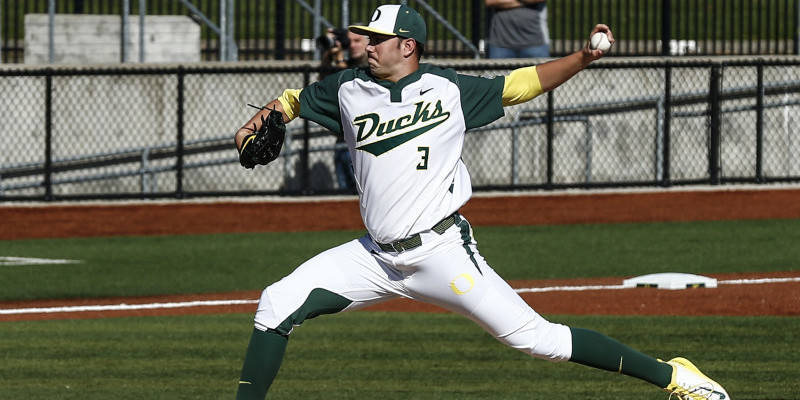This week’s player hasn’t been linked to the Royals in any mock drafts, but as you have seen but what we’ve seen and I’ve written about, the Royals aren’t afraid to get creative like they did in the ’09 and ’13 drafts. One strategy that could produce a nice get in the 1st round and open up more money in available rounds after would be to take a player who has been getting labeled toward the bottom of the 1st but could create big returns. One such player is Oregon pitcher, David Peterson. The left-handed starter has been one of if not the most impressive pitcher this college season. Just take a quick look at the numbers the lefty has put up to date:
9-2 74.1 IP 65 H 21 R 16 ER 6 BB 107 K
Yeah, a near 18/1 strikeout to walk ratio is tasty indeed. The lefty K’d 17 in his third start of the season and has hit double digits four times since with his latest magnificent 20 K outing versus Arizona State. So how does he miss all of these bats?
Let’s start with the 6’6 235 lbs frame that he tosses from a low 3/4 arm angle. The fastball touches the gun only in the 90-94 mph range, but it generates plenty of swing and miss. One of the reasons he can do this is from the arm side run he creates while also moving the ball up and down the zone. That fastball velocity isn’t quite the elite level velocity that you may want to see from a college pitcher considering he’s going to go from starting once every seven days to once ever five. That number doesn’t tell the entire story however as Frank Piliere noted over at d1baseball.com Peterson regularly uses his height to release at a 6.8 ft extension point. The major league average is 6′ meaning he’s getting the extra extension and the ball is flying at less distance to get on hitters quicker. That 94 mph fastball now appears closer to 96 or 97 mph to the hitters. When you’re looking at a starter starting every seven days to five days you’re wondering if they can carry that velocity. Given Peterson’s extension and body size, I’d be quite confident that he can not only hold velocity but that it will play up as long as he continues to extend in the way he does.
The fastball is just one part of Peterson’s arsenal though. It’s really the thoughts of him having not one but two plus offerings in his secondary pitches that would be the key in my mind. The best of his secondary pitches is his slider currently with a two-plane break with late movement in the low to mid-80s. The pitch has the shape and tilt of a truly above average major league pitch and should be a weapon that he’s able to use to both right-handed and left-handed hitters at the pro level.
Notched down a tick but not much is his curveball, which he works in the mid to upper 70s. The big lefty shows such an aptitude for spin that he’s able to vary between the slider and curveball in the same sequence to hitters. Working the slider on a back foot to a righty and then breaking off a downer curveball to get rid of them. The curve over time could register in as a second above average offering next to the slider in the 55/60 range.
Lastly is the change up which now is a tick below average pitch and could use some refinement. The arm speed is okay, but the control wavers and with two plus breaking balls, it is often an afterthought at the college ranks. As a freshman, he threw it more often trying to get weak contact as he used his two-seam fastball more, but as he’s switched to the four-seam it has been used less. It does feature some arm side fade in the low 80s.
At a slot or below slot deal Peterson is a pitcher with two and maybe three above average offerings depending on how much you like the curve. Add that with a durable body that can carry innings and the Royals could be getting a workhorse pitcher who, if he can refine the changeup, could develop into a solid mid-rotation starter who could move quickly through the minor leagues. This isn’t the sexy high ceiling pitcher that scouts typically draft but features a high floor with a higher ceiling than some see on paper based on those extension figures. On top of that, I believe what the Royals have done best in development is adjust a pitcher’s changeup and make it a better offering as they’ve done with Danny Duffy, Yordano Ventura, and a few others. That’s why this pitcher would be as good a fit to this organization as any that we will likely see on their board.
Featured Photo Dave Peaks FishDuck.com

1 comment on “It’s Never Too Early to Discuss the Draft, David Peterson Edition”
Comments are closed.